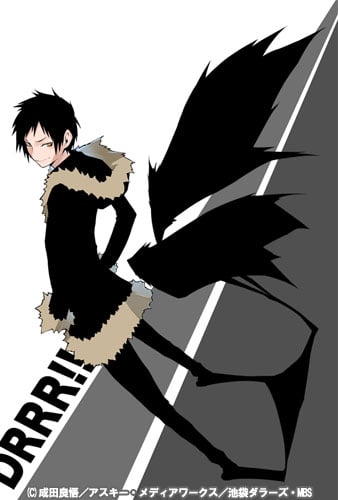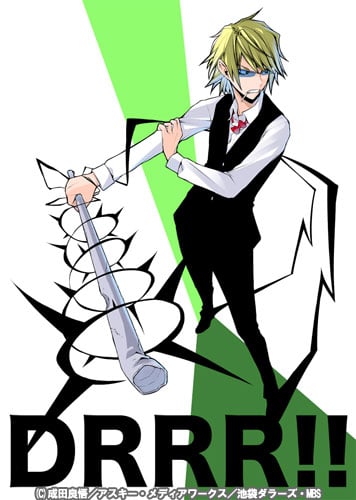Share this link via
Or copy link
Below are navigation links that will take you to the main text and navigation menus.
26,551 first names, 70,620 last names, 333,585 kanji variations.
one of the best Japanese name search tools for your baby!

Image by: Durarara official website ©Ryohgo Narita/ AsciiMediaWorks/ Ikebukuro dollars/ MBS
Contents
Durarara!! is the anime adaptation of a popular novel series written by Ryohgo Narita and illustrated by Suzuhito Yasuda. A high school student named Mikado Ryugamine was bored with his life. Wishing for excitement, he moves to Ikebukuro, Tokyo to join Raira academy where his childhood friend Masaoki Kido attends. The story switches between the 11 main character’s points of view featuring the strange things happening in the big city which slowly starts to change Mikado’s life into an unusual one.

Image by: Durarara official website ©Ryohgo Narita/ AsciiMediaWorks/ Ikebukuro dollars/ MBS
The Japanese title of this series is ‘デュラララ!!, Durarara!!’. The anime is divided into 4 parts, it begins with ‘Durarara!!’, continues to ‘Durarara!! ‘承’(Shou), ‘Durarara!! ‘転’(Ten), and ends with Durarara!! ‘結’(Ketsu). These letters come from the word ‘起承転結’(Kishōtenketsu) which means the 4 major parts of a story. ‘Ki’(起) is the introduction of the story and the kanji means to wake up, ‘Shou’(承) is the development and the kanji means to accept, ‘Ten’(転) means to turn and it is the part of the story with a twist, and finally ‘Ketsu’(結) means the conclusion.

Image by: Durarara official website ©Ryohgo Narita/ KADOKAWA corporation
In Japanese culture, names have significant meanings that are supposed to represent you as a person. Names can be expressed in hiragana, katakana, and kanji. Let’s find out the meanings of some names of characters in Durarara!!

Image by: Durarara official website ©Ryohgo Narita/ AsciiMediaWorks/ Ikebukuro dollars/ MBS
Mikado is a shy and kind boy who looks for an exciting life and later becomes the leader of the color gang. ‘Ryu’(竜) means dragon, ‘Ga’(ヶ) is a small Katakana-like letter which has no meaning itself but is often used to connect two letters, ‘Mine’(峰) is a peak, ‘Mika’(帝) is an emperor, and ‘Do’(人) is a person.

Image by: Durarara official website ©Ryohgo Narita/ AsciiMediaWorks/ Ikebukuro dollars/ MBS
Masaomi, the leader of the yellow color gang is a cheerful young boy who invited Mikado to come to his school in Tokyo. ‘Ki’(紀) means era, ‘Da’(田) is a paddy puddle, ‘Masa’(正) means correct, and ‘Omi’(臣) is a retainer.

Image by: Durarara official website ©Ryohgo Narita/ AsciiMediaWorks/ Ikebukuro dollars/ MBS
Izaya is a young man who sells information in Ikebukuro. He enjoys manipulating people in order to watch their reactions and is often the person behind miseries. ‘Ori’ (折) is to fold, ‘Hara’(原) means field, ‘Iza’(臨) means to deal and ‘Ya’(也) is a common kanji used at the end of boys’ names.

Image by: Durarara official website ©Ryohgo Narita/ AsciiMediaWorks/ Ikebukuro dollars/ MBS
Shizuo is known as the strongest person in Ikebukuro. The two kanji’s ‘Heiwa’(平和) means peace, ‘Jima’(島) is an island, ‘Shizu’(静) means quiet and ‘O’(雄) is male. Unlike his name, he is violent and loses his temper very easily.

Image by: Durarara official website ©Ryohgo Narita/ AsciiMediaWorks/ Ikebukuro dollars/ MBS
Shinra, is an underground doctor and a friend of Izaya and Shizuo. Most of the time he stays at home with his partner the ‘headless rider’. ‘Kishi’(岸) means the shore, ‘Tani’ (谷) is a valley, ‘Shin’(新) is new and ‘Ra’(羅) is a type of fabric.
Here are some useful phrases from Durarara!! which will help you along with your Japanese studies!

Image by: Durarara-Saika comic 3 Ep 11 ©Ryohgo Narita/ KADOKAWA corporation
Izaya and Shizuo are arch enemies. ‘Kore’(これ) means this and ‘Dakara’(だから) means because. ‘Ore’(俺) is what boys call themselves. ‘Chan’(ちゃん) is a word to put after a name, it can be used for little girls or even as a nickname for a friend. ‘Kirai’(嫌い) means I don’t like and when you put ‘Dai’(大) which means big, it becomes ‘Daikirai’(大嫌い) which means Hate!

Image by: Durarara-Saika comic 1 Ep 1 ©Ryohgo Narita/ KADOKAWA corporation
This is a short form of ‘Maji desu ka’ and is commonly used by Japanese youngsters. ‘Maji’ means serious and desuka is asking politely.
Sort by Most Kanji Variations
This is the order of names with many variations of kanji.
Basically, names with more variations are more common and familiar to the Japanese.
Sort by Most Viewed
The names are sorted by the number of times they have been viewed on this site. This ranking is based on the behavior of users around the world, including Japan, so it does not mean that the names are commonly viewed by Japanese people only.
Please note that just because a name has been viewed more times does not mean it is a famous name in Japan.
What is Hiragana?
Hiragana is a syllabary used in written Japanese, which originated from the cursive style of Kanji.
What is Katakana?
Katakana is also a Japanese syllabary. Basically, the characters don't have any meaning by themselves, they only represent the sounds.
Japanese try to express the words came from foreign languages with the most similar sounds in Japanese using Katakana.
What is English Transcription?
English Transcription is a term used when translating Japanese names into English. It represents a romanised version of the name with the aim of reproducing the pronunciation as accurately as possible. English Transcription can also be used for name searches.
Japanese Style Nickname
In Japan, nicknames are commonly used to express familiarity and affection. Here are key features and contexts:
Shortened Forms: Names are often shortened for ease and intimacy, such as 'Yuki' from 'Yukiko' or 'Taka' from 'Takashi'.
Suffixes: Terms like 'chan' for girls and 'kun' for boys are added to names among close friends and family. However, 'chan' can also be used for boys during childhood. Additionally, among adults who are very close, like best friends, 'chan' may still be used to convey affection and familiarity. More Details
Usage and Cultural Aspects: Nicknames are typically used in informal settings among friends, family, or close colleagues, and are not suitable for formal or professional environments. The use of a nickname suggests a degree of intimacy and should reflect the nature of the relationship. Young people often demonstrate creativity in their social interactions by crafting unique nicknames.
Note: In Japanese, the long vowel sound is indicated by a special character called a "chōonpu" (長音符), which looks like a horizontal dash (ー). This character serves to extend the duration of the vowel sound immediately preceding it. For instance, in the name "あーちゃん" (A-chan), the "あ" (A) is extended, producing a prolonged "ah" sound, similar to the "a" in "father."
Households?
The names are sorted by the number of Japanese households where the surname is used.
The more households there are, the more famous and common the surname is.
About this site's data of last names
